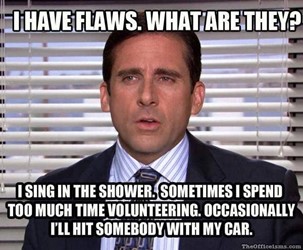5 experiments to make your team feel safe – and thrive!
Every leader wants to create an environment for people to be their fabulous, full selves – free to speak up, and share ideas; flag failures, and learn from them. When people don’t feel ‘safe’, business simply doesn’t boom. Collaboration is crippled; creativity and innovation are stifled as people put self-preservation before progress.
We all get the theory, but how do you make a team ‘feel safe’ in practice? If people are busy watching their back – rather than getting stuff done – try some of these experiments and see how they impact the trust, creativity and productivity of your team.
Experiments

1. Do the positive reps: ‘You’re amazing because…’
Everyone loves talking about ‘radical candor’, and it’s frequently sited as being critical for innovation. Isn’t it refreshing to cut the bull and let each other know exactly what we think?! Nice in theory, but in reality what’s often missed is the hard work involved in making people feel genuinely cared for, so they appreciate the frank feedback when it comes.
We’re all geared up to spot danger and hardwired to pick up negative comments, cynical smirks, loaded silences or rolled eyeballs… and the more we pick up, the less we want to collaborate. We also have finely tuned bullshit-o-meters screening out meaningless compliments and pointless politeness.
To lay the foundations of trust – and create the environment where ‘radical condor’ can really flourish – do the hard yards: frequently let people know why they’re amazing. Support it with specific, tangible FACTS they can’t brush off.

2. Lead with questions (not commands!)
Ever feel like Flash Gordon with only fourteen minutes to save the Earth? We’ve all been there – time is tight, stakes are high, and suddenly we’re telling people WHAT NEEDS TO GET DONE. Bad idea! When your team don’t feel valued as contributors – more like extras in your own personal (disaster) movie – they stop taking risks and making decisions, effectively blasting your odds of success (not so Flash now…)

Would your team get in a wheelbarrow for you?
In 1859, Charles Blondin wowed 25,000 people by crossing Niagara Falls on a tightrope, while pushing a wheelbarrow. When he asked the crowd if they thought he could cross back again, they all cheered! When he asked for a volunteer to sit in the wheelbarrow, the silence was deafening…
Finally, one volunteer stepped up to climb into the wheelbarrow: Blondon’s manager and long-time friend was the 1 person in 25,000 with whom he had a firmly established sense of trust. (Worry not, they both made it safely back!)

3. Yes… and?
We’ve all felt the sting of sharing a brilliant idea, only to have it ignored – or worse, mercilessly shot down! Too many rejections, and you’re going to have people holding back. Yet a leader can’t say ‘yes’ to every idea, simply to spare the feelings of the person who had it! So how do we keep the ideas flowing, without losing our quality filter?

Don’t rush to flush ideas down the loo…
Some friends of TCX were brainstorming a new type of toilet cleaner (ah, the glamour). After getting nowhere slowly, one exasperated soul suggested they just throw a hand grenade down the toilet: one small explosion, and da-daa! No more toilet to clean!
Rather than dismissing the idea, the group questioned the principles behind it: no effort… explosive… dramatic. They set about replicating these qualities, and boom! A new product ‘the toilet bomb’ was created.

4. Embrace failures – particularly your own!
Learning anything new is messy – you can’t get from trying to succeeding without the odd slip-up. But you’re going to have to convince your team to start ‘celebrating failure’ (who really gets promoted for messing up?) Be honest about your own struggle, and you’ll build the resilience of those around you.

Rinse out your mistakes
Following every engagement, the US military perform an After Action Review – or ‘hotwash’. Whether it follows a quick training exercise, or co-ordinating disaster relief for Hurricane Katrina, the senior leaders are always first to step up – exposing and analysing areas where they’ve ‘messed up’, and creating an environment where mistakes are respected as lessons (no matter how hard).

5. How was it for you?
So often in business, it’s all about…well, doing business. Polite enquiries (‘how are you?’/ ‘how was your weekend?’) are frequently dismissed – at your peril! Our productivity at work is impacted by how we’re doing outside of it. Find out people’s personal context – what gets them excited, their hopes, their hobbies – and you can care for each other more usefully, and work better as a team.
Call (Centre) of Duty
High staff turnover is a problem face by many call centres. But WIPRO improved their call centre talent retention rate by 250% by making a small tweak to their induction process.
After the usual talk about WIPRO and its values, managers asked trainees questions about themselves and their values. (‘What floats your boat?’)
By showing an interest in them as real people (‘OMG, you weren’t born with a headset attached?’) WIPRO signalled staff were valued and belonged. In return, recruits were immediately more loyal to WIPRO, and worked with greater commitment.
Try this experiment
Start team meetings with a question that allows people to share how they’re feeling. Provide small, fun steps that make it easy (and safe) to express how they’re doing, and what they’ve been up to.
Rating from 1-10, what’s your energy score right now? Tell us how you got there!
Compare your week (so far) to a ready meal: meatballs all the way… or a carton of exploded soup?
Grab a pen and paper, and draw a quick pic of what you got up to at the weekend!
Final Thoughts: Keep it light… but keep it real
Psychological safety isn’t just a buzzword; it’s the air a thriving team breathes. It’s not about being soft, but about being open, curious, and willing to laugh (especially at ourselves). Do the ‘positive reps’, keep the questions coming, embrace the failures, and you might be surprised by who hops into your wheelbarrow.
Got any stories from your own team adventures? Share them in the comments!
The Culture Experiment is here to inspire the way we work and live. In these times of unprecedented change, success comes not from what we know, but how willing we are to learn. When we’re all inventing the ‘new normal’, there are no right answers – just informed hunches, bold ideas, and the courage to act on them.
It’s time to stop wishing, cease wondering, and put ourselves to the test.
TRY, LEARN, REPEAT
We bring you the latest in evidence-based hypotheses, and generate practical experiments to get people in business more energized, agile and resilient. We share the big new ideas, and small stunning insights to help you collaborate and create brilliantly together.
Yesterday is a foreign country, they did things differently there.
So what can we discover today to transform tomorrow?







